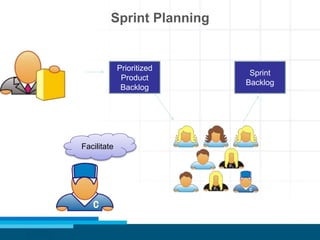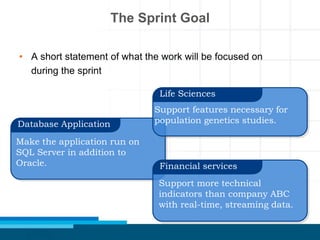Practicing Agile through Scrum
- 1. 1 Practicing Agile through Scrum Naveen Kumar Singh, PMP, PMI-ACP, CSM VP – Program, PMI North India Chapter
- 2. • Scrum is an agile process that allows us to focus on delivering the highest business value in the shortest time. • It allows us to rapidly and repeatedly inspect actual working software. • The business sets the priorities. Teams self-organize to determine the best way to deliver the highest priority features. • Every two weeks to a month anyone can see real working software and decide to release it as is or continue to enhance it for another sprint. Scrum in 100 words
- 3. Characteristics • Self-organizing teams • Product progresses in a series of month-long “sprints” • Requirements are captured as items in a list of “product backlog” • No specific engineering practices prescribed • One of the “agile processes”
- 4. Scrum Cancel Gift wrap Return Sprint 30 Days Return Sprint goal Sprint backlog Potentially shippable product increment Product backlog CouponsGift wrap Coupons Cancel 24 hours
- 5. Source: “The New New Product Development Game” by Takeuchi and Nonaka. Harvard Business Review, January 1986. Rather than doing all of one thing at a time... ...Scrum teams do a little of everything all the time Requirements Design Code Test Sequential Vs. Overlapping Development
- 6. Scrum Framework •Scrum Master •Product Owner •Team Roles •Sprint planning •Daily scrum meeting •Sprint review •Sprint retrospective Ceremonies •Product backlog •Sprint backlog •Increment Artifacts
- 7. Sprint - The Exploration Cycles
- 8. Sprints • Scrum projects make progress in a series of “sprints” • Analogous to Extreme Programming iterations • Typical duration is a calendar month at most • Product is designed, coded, and tested during the sprint Sprint 30 Days
- 9. Characteristic of Sprint Sprint Timeboxed Short Duration Consistent duration Goal shouldn’t be altered once started
- 10. Selecting Sprint Length • Length of the release • Amount of uncertainty • How easy is to get feedbacks • Stability of priorities • The overhead of iterating • Give a feeling of urgency
- 11. Short Duration Short Duration Ease of Planning Fast feedback Expose Issues Improved return on Investment Rejuvenating Frequent Check point
- 13. Scrum Roles
- 15. Scrum Master I never teach my pupils; I only attempt to provide the conditions in which they can learn. —Albert Einstein
- 16. Scrum Master • Observes the team and ensures adherence to scrum rules • Responsible for enacting Scrum values and practices • Introduces Scrum Roles to the team • Coach & Manage Team Members
- 17. Scrum Master • Create productivity team • Acts as a team moderator. • The Facilitation of daily Scrum • Remove hurdles or any other external interference • Improve the engineering practices and tools.
- 18. Scrum Master • Remove the barriers between development and the Product Owner. • Teach the Product Owner how to maximize ROI. • Shield the team from external interferences • Keep information about the team’s progress up-to-date and visible to all parties.
- 19. Dos Don’ts Guides and facilitates Direct or drive Keeps everyone focused on delivering business value Stick to deadlines and approaches that no longer work Has a keen interest in the team’s overall Performance Become attached to specific outcomes from the team Coaches the team for high performance Get involved in task-level direction Promotes the skills and growth of every team member Become the only voice of the team Scrum Master Behaviours
- 20. Product Owner
- 21. Product Owner • Mouthpiece of stakeholders and customers. Facilitate the scrum financing. • Ensures profit returns from the product development and its launch in the market (ROI).
- 22. Product Owner • Visualizes the conception, management, outcome, and launch of the product. • Decide on release date and content • Prioritize features according to market value
- 23. Product Owner • Controls the right use of backlog. • Has right to accept or reject the outcome of the project. • Adjust features and priority every iteration, as needed • Accept or reject work results
- 24. Product Owner is CRACK • Committed to the work and engaged in it fully • Responsible for the outcome • Authorized by the person paying the bills to make decisions about the product under development and to know which decisions can be made solo and which require consultation with others • Collaborative as a normal mode of interacting with people • Knowledgeable about the business purposes of the endeavor and the business domain itself
- 25. Development Team
- 26. Development Team • Responsible for product quality, estimation, and delivery. • Responsible for converting product backlog into shippable product • Responsible for managing their day to day tasks
- 27. Development Team • Makes Rules for living together • Identifies missing items in Product Backlog • Prepares Sprint Backlog • Prepares definition of Done
- 28. Development Team • It is right sized i.e. 3 to 9 • It is self dependent which means it is self managed and self organized. • It is also multifunctional. • Interlaces with customers, end users, PO, and even PMOs (project management organizations)
- 29. Scrum Ceremonies
- 30. Sprint Planning
- 31. Sprint Planning • The Team and the Product Owner collaborate to help the Team determine how much Product Backlog it can turn into functionality during the upcoming Sprint. • The Team create plans (Sprint Backlog) by identifying tasks for converting selected Product Backlog into functionality
- 32. Sprint planning meeting Sprint prioritization • Analyze and evaluate product backlog • Select sprint goal Sprint planning • Decide how to achieve sprint goal (design) • Create sprint backlog (tasks) from product backlog items (user stories / features) • Estimate sprint backlog in hours Sprint goal Sprint backlog Business conditions Team capacity Product backlog Technology Current product
- 34. Sprint Planning • Team selects items from the product backlog they can commit to completing • Sprint backlog is created • Tasks are identified and each is estimated (1-16 hours) • Collaboratively, not done alone by the Scrum Master • High-level design is considered As a vacation planner, I want to see photos of the hotels. Code the middle tier (8 hours) Code the user interface (4) Write test fixtures (4) Code the foo class (6) Update performance tests (4)
- 36. Why Daily Scrum? • Fine-grain coordination • Daily commitment • Raising impediments • Peer pressure • Access Progress towards sprint goal • Replanning
- 37. The Daily Scrum • Parameters • Daily • 15-minutes • Stand-up • Not for problem solving • Only team members, Scrum Master, Product Owner, can talk • Helps avoid other unnecessary meetings • Team is responsible of conducting this meeting
- 38. Daily Scrum Facilitate Observe What did you do yesterday? 1 What will you do today? 2 Is anything in your way? 3 These are not status for the Scrum Master • They are commitments in front of peers
- 39. Sprint Review
- 40. The Sprint Review • Team presents what it accomplished during the sprint • Typically takes the form of a demo of new features or underlying architecture • Informal • 2-hour prep time rule • No slides • Whole team participates • Invite the world
- 41. Sprint Review Facilitate Feedback on Product Feedback on Product Demo
- 43. Sprint Retrospective • Periodically take a look at what is and is not working • Done after every sprint • Participants • Scrum Master • Team • Product owner (Optional)
- 44. Sprint Retrospective Meeting A meeting time-boxed for 3 hours and facilitated by the Scrum Master at which the Team discusses the just-concluded Sprint and determines what could be changed that might make the next Sprint more enjoyable or productive.
- 45. Start / Stop / Continue Facilitate Observe Start doing Stop doing Continue doing This is just one of many ways to do a sprint retrospective
- 46. Scrum Artifacts
- 48. Product Backlog
- 49. Product Backlog • The requirements • A list of all desired work (Product Backlog Item) on the project • Ideally expressed such that each item has value to the users or customers of the product • Prioritized by the product owner • Reprioritized at the start of each sprint
- 50. Good Product Backlog • Good product backlogs should be DEEP (Coined by Roman Pichler and Mike) • Detailed appropriately • Emergent • Estimated • Prioritized
- 51. Constituents Of Product Backlog PBI Type Example Feature As a job seeker I want to search job using keywords so that I can find the suitable job Change As a job seeker I want default ordering od job search results to be by freshness rather than location so that its easier to see latest jobs first Defects Fix defect #245 so that special character in search wont crash the system Technical Improvement Move to the latest version of Internet Explorer Knowledge Acquisition Create prototype using two databases (RDMS and NO SQL) and run performance test to determine which would be better approach for our system.
- 52. A Sample Product Backlog Backlog Item Estimate Allow a guest to make a reservation 3 As a guest, I want to cancel a reservation. 5 As a guest, I want to change the dates of a reservation. 3 As a hotel employee, I can run RevPAR reports (revenue-per-available-room) 8 Improve exception handling 8 ... 30 ... 50
- 53. Sprint Backlog
- 54. Sprint Backlog • The Sprint Backlog defines the work the Team will perform to turn Selected Product Backlog items into a “Done” Increment. • The list emerges during the Sprint. • Each ongoing task identifies those responsible for doing the work • Each Tasks has information about estimated amount of work remaining on the task on any given day during the Sprint.
- 55. The Sprint Goal • A short statement of what the work will be focused on during the sprint Database Application Financial services Life Sciences Support features necessary for population genetics studies. Support more technical indicators than company ABC with real-time, streaming data. Make the application run on SQL Server in addition to Oracle.
- 56. Sprint Backlog Sprint Backlog Sprint Planning During the Day Daily Scrum Maintain
- 57. Increment
- 58. The Increment • The Increment is the sum of all the Product Backlog items completed during a Sprint and all previous Sprints. • At the end of a Sprint, the new Increment must be “Done,” • It must be in useable condition (Potentially shippable product)
- 60. Definition of Done • Everyone must understand what done means • This varies significantly per Scrum Team, members must have a shared understanding of what it means for work to be complete, to ensure transparency • This guides Development Team in knowing how many Product Backlog items it can select during a Sprint Planning Meeting. • The purpose of each Sprint is to deliver Increments of potentially releasable functionality that adhere to Definition of “Done.” • Definition of Done may change during the project
- 61. Stay Connected Naveen Kumar Singh [email protected] References - http://www.mountaingoatsoftware.com/ www.izenbridge.com





























































